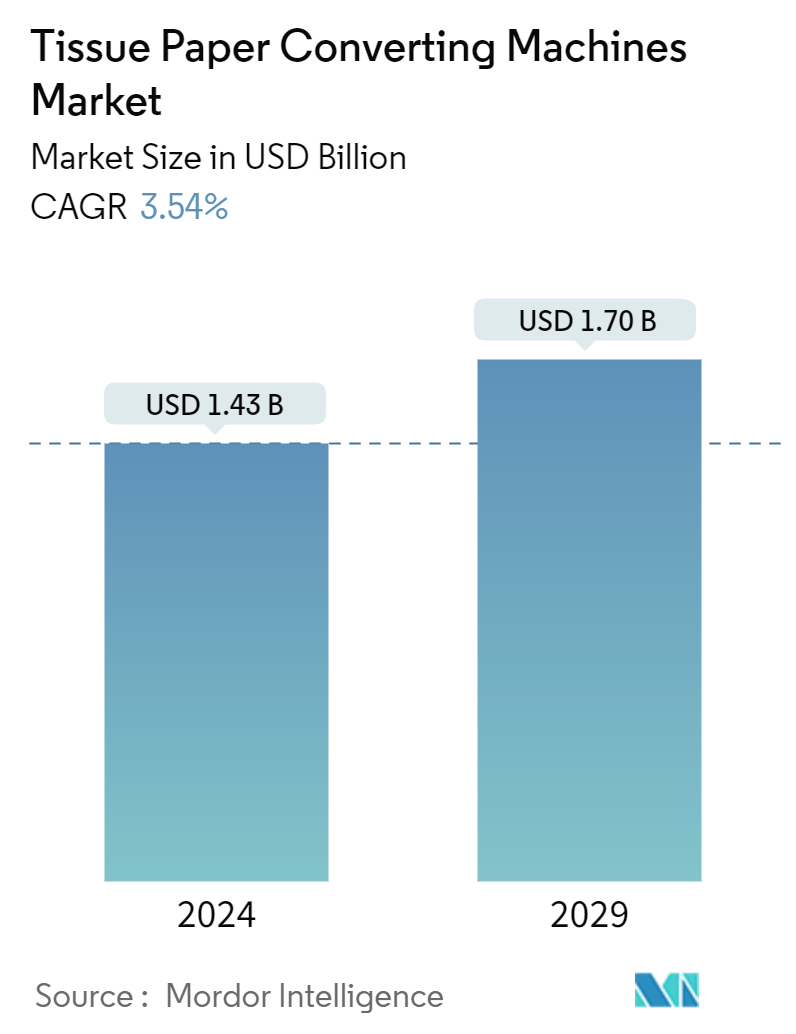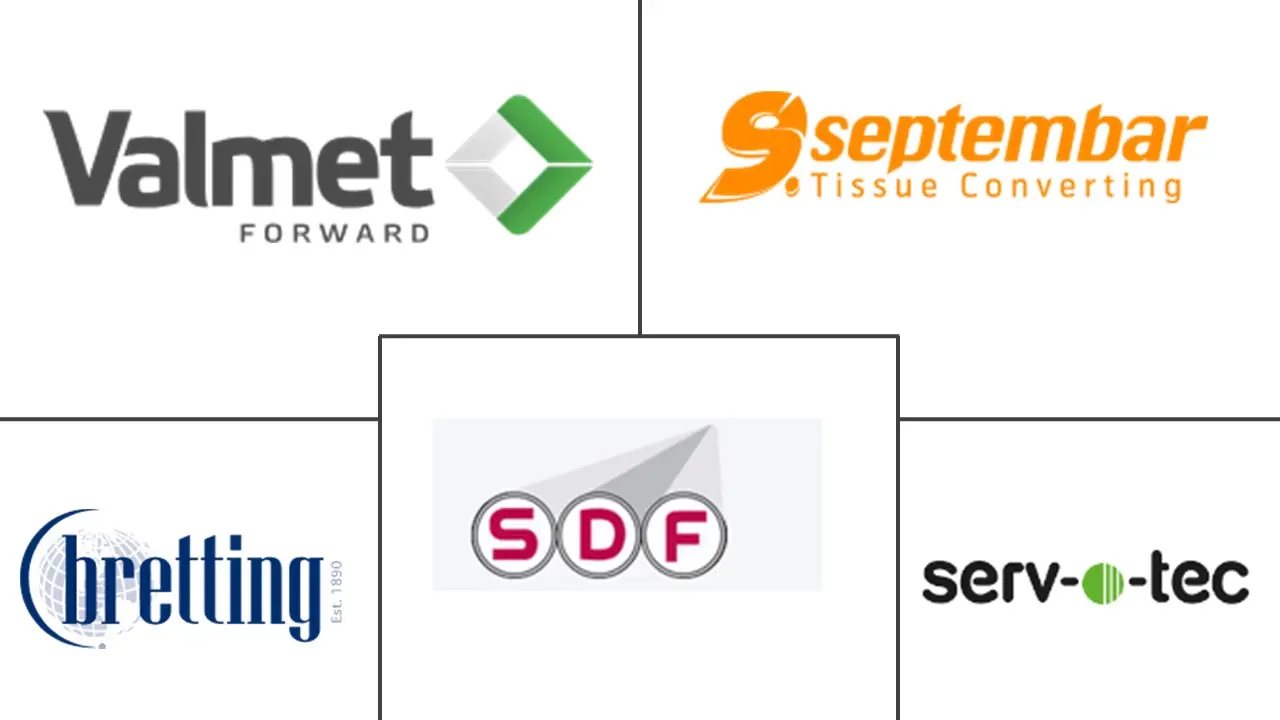
| Study Period | 2019 - 2029 |
| Market Size (2024) | USD 1.43 Billion |
| Market Size (2029) | USD 1.7 Billion |
| CAGR (2024 - 2029) | 3.54 % |
| Fastest Growing Market | Asia Pacific |
| Largest Market | Asia Pacific |
| Market Concentration | Low |
Major Players
*Disclaimer: Major Players sorted in no particular order |
Tissue Paper Converting Machines Market Analysis
The Tissue Paper Converting Machines Market size is estimated at USD 1.43 billion in 2024, and is expected to reach USD 1.70 billion by 2029, growing at a CAGR of 3.54% during the forecast period (2024-2029).
Tissue paper production has a significant impact on the environment. Tissue paper is made from recycled wastepaper and virgin pulp, contributing to greenhouse gas emissions (estimates state that virgin pulp contributes 30% more than wastepaper). With the escalating concerns about environmental sustainability, tissue paper converting equipment manufacturers are extensively implementing green manufacturing models. This includes using recycled materials, reducing water and energy consumption, and adopting processes that minimize environmental impact.
- In tissue paper manufacturing, research and development efforts remain focused on several key areas, including energy saving, fiber saving, final product quality, and the ability to run the machine. The approach flow and headbox area are some of the most energy-intensive stages in tissue-making. Manufacturers are actively exploring new smart options to optimize this area, aiming to achieve better stock homogenization, facilitate quick grade changes, and work toward higher consistencies in the headbox. These efforts are essential for improving overall process efficiency, reducing energy consumption, and enhancing the quality of tissue paper products.
- The integration of smart technology and automation is on the rise, helping to improve overall operational efficiency, reduce waste, and enhance accuracy. Also, the demand for high-speed, fully automated converting lines is expanding, along with rising labor costs and efficiency demands. The fully automatic converting machines reduce waste and the need for human intervention by connecting different processes, such as winding and packaging. Major companies spend heavily on cutting-edge robots, vision, and artificial intelligence-driven optimization as they expand into new manufacturing areas.
- Innovative converting technologies facilitate the efficient utilization of raw materials, particularly paper fibers. Precision cutting and embossing techniques are examples of methods that reduce material waste, while advanced control systems optimize the consumption of water and chemicals during manufacturing.
- The initial investment needed to establish a tissue-converting plant can be substantial, covering expenses like land procurement, building construction or renovation, machinery purchase and installation, and infrastructure development. Much of the capital will be required as working capital, while the cost of machinery and equipment can be as high as 25% or more of the total investment. Securing enough capital for these costs can be tough, especially for small or new businesses. Factors like limited financial resources, perceived risk, and regulatory compliance further complicate the funding process. To address these challenges, businesses may seek partnerships, explore government support programs, develop thorough business plans, and optimize costs to enhance financial viability.
- According to a report published by AFRY (Paper industry specialist) and Suzano (a key global paper and pulp producer), the global consumption of paper is expected to rise to a massive 55 million tons in 2032 from 41 million tons in 2021. This rising demand for tissue paper across the globe would open opportunities for many small and medium-scale producers to enter the tissue paper manufacturing industry, thereby increasing the demand for converting equipment.
Tissue Paper Converting Machines Industry Segmentation
The study tracks the revenue generated from the sales of tissue paper converting machines offered by the vendors operating in the market. The scope of the study includes the cost of integrated service and consumables offered with the purchase of the machine, and it excludes the after-sales service cost. The study provides market estimates and forecasts in terms of revenue (USD) for key segments. The market study factors are based on the prevalent base scenarios, key themes, and end-user vertical-related demand cycles.
The tissue paper converting machines market is segmented by technology (automatic and semi-automatic), machine type (toilet roll converting lines, kitchen roll converting lines, folded tissue-converting lines, paper napkin converting lines, and standalone systems), and geography (North America [United States and Canada], Europe [Germany, France, Italy, United Kingdom, and Rest of Europe], Asia-Pacific [Japan, India, China, Indonesia, and Rest of Asia-Pacific], Latin America, Middle East and Africa). The report offers market forecasts and size in value (USD) for all the above segments. The study also tracks the key market parameters, underlying growth influencers, and major vendors operating in the industry, which supports the market estimations and growth rates during the forecast period.
| Automatic |
| Semi-automatic |
| Toilet Roll Converting Lines |
| Kitchen Roll Converting Lines |
| Folded Tissue Converting Lines |
| Paper Napkin Converting Lines |
| Standalone Systems |
| North America | United States |
| Canada | |
| Europe | Germany |
| France | |
| Italy | |
| United Kingdom | |
| Asia | Japan |
| India | |
| China | |
| Indonesia | |
| Australia and New Zealand | |
| Latin America | |
| Middle East and Africa |
Tissue Paper Converting Machines Market Size Summary
The tissue paper converting machines market is poised for steady growth, driven by increasing demand for tissue products such as toilet paper and paper towels. This demand is fueled by factors like population growth, urbanization, and heightened hygiene standards. Manufacturers are focusing on integrating smart technologies and automation to enhance operational efficiency, reduce waste, and improve product quality. The adoption of eco-friendly practices is also on the rise, with companies investing in machinery capable of processing recycled fibers and minimizing environmental impact. As consumer preferences shift towards personalized and innovative products, flexible converting machinery that offers customization capabilities is becoming increasingly important.
The market landscape is characterized by fragmentation, with key players like C.G. Bretting Manufacturing Company, Inc., Valmet Oyj, and others actively engaging in partnerships and acquisitions to strengthen their market position. The initial investment for establishing a tissue-converting plant can be substantial, posing challenges for small or new businesses. However, the rising global consumption of paper presents opportunities for small and medium-scale producers to enter the market. Innovations in converting technologies, such as precision cutting and embossing, are facilitating efficient raw material utilization and reducing waste. The market is also witnessing advancements in packaging and dispensing systems, catering to evolving consumer needs and preferences.
Tissue Paper Converting Machines Market Size - Table of Contents
1. MARKET DYNAMICS
-
1.1 Market Drivers
- 1.1.1 Growing Trend of Automation in Tissue Manufacturing Industry
- 1.1.2 Innovation in the Converting Technologies to Improve Sustainability
-
1.2 Market Restraints
- 1.2.1 High Setup Cost for Tissue-converting Plant
- 1.3 Key Innovations and Developments – Tissue-converting and Auxiliary Equipment
- 1.4 Industry Standards and Regulations
2. MARKET SEGMENTATION
-
2.1 By Technology
- 2.1.1 Automatic
- 2.1.2 Semi-automatic
-
2.2 By Machine Type
- 2.2.1 Toilet Roll Converting Lines
- 2.2.2 Kitchen Roll Converting Lines
- 2.2.3 Folded Tissue Converting Lines
- 2.2.4 Paper Napkin Converting Lines
- 2.2.5 Standalone Systems
-
2.3 By Geography***
- 2.3.1 North America
- 2.3.1.1 United States
- 2.3.1.2 Canada
- 2.3.2 Europe
- 2.3.2.1 Germany
- 2.3.2.2 France
- 2.3.2.3 Italy
- 2.3.2.4 United Kingdom
- 2.3.3 Asia
- 2.3.3.1 Japan
- 2.3.3.2 India
- 2.3.3.3 China
- 2.3.3.4 Indonesia
- 2.3.4 Australia and New Zealand
- 2.3.5 Latin America
- 2.3.6 Middle East and Africa
Tissue Paper Converting Machines Market Research FAQs
How big is the Tissue Paper Converting Machines Market?
The Tissue Paper Converting Machines Market size is worth USD 1.48 billion in 2025, growing at an 3.54% CAGR and is forecast to hit USD 1.76 billion by 2030.
What is the current Tissue Paper Converting Machines Market size?
In 2025, the Tissue Paper Converting Machines Market size is expected to reach USD 1.48 billion.


